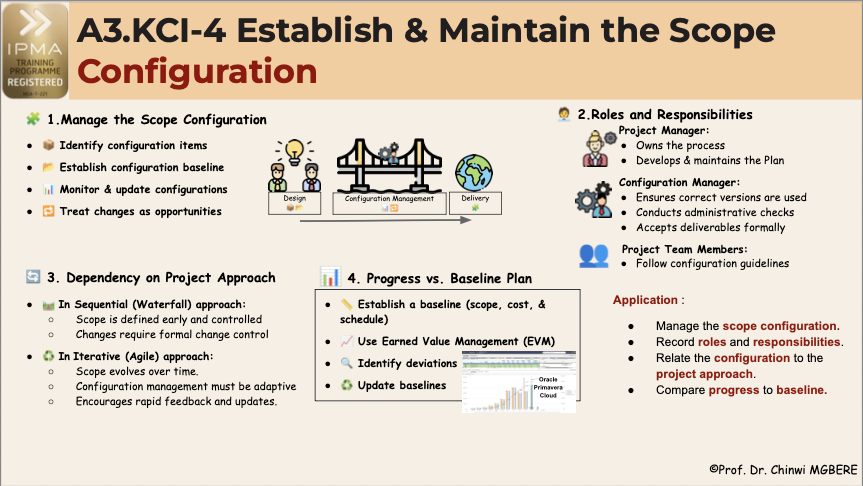- Manages the scope configuration
- Defines roles and responsibilities related to scope configuration management
- Relates the dependency of scope configuration and the overall approach to the project (sequential or iterative)
- Compares progress and earned value against a baseline plan
2 CPD Hours

A3.KCI-4: Establish and Maintain Scope Configuration
1. Manage the Scope Configuration
Scope configuration management ensures that every team member is working from the same version of the product, reducing the risk of errors, omissions, and scope creep.
It maintains alignment between the actual deliverables and what was originally agreed upon with stakeholders – Bridging design and delivery.
Key Actions include:
- Identify configuration items (e.g., documents, product versions, technical components) that must be controlled.
- Establish a configuration baseline that reflects agreed scope and requirements.
- Continuously monitor and update configurations as the project evolves, especially in dynamic or iterative environments.
- Treat changes as opportunities for refinement, not as obstacles.
Projects using Agile or iterative methods benefit from scope configuration the most, as it promotes adaptability while maintaining control.
2. Roles and Responsibilities Related to Scope Configuration Management
Clearly defined roles related to scope configuration management prevent miscommunication, duplication of effort, and misaligned expectations. Each person knows their responsibility in maintaining scope integrity.
Key Responsibilities include:
-
Project Manager:
- Owns the scope configuration process.
- Develops and maintains the Configuration Management Plan.
- Configuration Manager:
- Ensures only correct and approved versions are used.
- Conducts administrative checks and oversees compliance with procedures.
- Accepts all deliverables formally, ensuring sign-off is completed.
- Project Team Members:
- Follow configuration guidelines and submit deliverables accordingly.
A Configuration Register can help track all items, their version history, and current status
3. Relate the Dependency of Scope Configuration and the Overall Project Approach
The way you manage scope configuration depends on whether your project follows a sequential (waterfall) or iterative (agile) approach.
Key Considerations:
Remember: Your project approach informs how often and how rigorously configuration updates should occur.
4. Compare Progress and Earned Value Against a Baseline Plan
Evaluating progress and value against a configuration baseline helps determine whether the project is delivering what was promised—on time and within budget.
Key Actions include:
- Establish a baseline that captures scope, cost, and schedule expectations.
- Use Earned Value Management (EVM) to track actual progress vs. planned value.
- Identify deviations from the baseline and assess if scope changes have been properly integrated through configuration control.
- Update baselines when changes are approved, to reflect new scope realities.
Insight: Proper scope configuration ensures your earned value metrics remain meaningful and relevant.
To apply these actions to your current initiative, follow these steps:
- Manage the Scope Configuration by identifying key items (documents, deliverables). Control versions using tools like Oracle Primavera Cloud, and ensure all changes follow an approval process.
- Define Roles and Responsibilities by assigning a configuration manager, clarify roles with a RACI matrix, and ensure the team follows agreed procedures.
- Relate the configuration to Project Approach by matching configuration practices to your delivery model—formal for sequential projects, flexible for agile ones
- Compare Progress to Baseline by setting a scope-cost-schedule baseline. Use EVM to track performance against the baseline, and update it only after approved scope changes.


